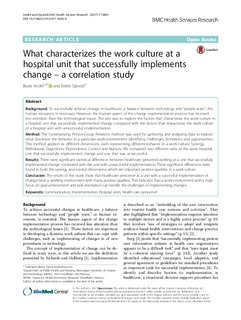| dc.contributor.author | Andre, Beate | |
| dc.contributor.author | Sjøvold, Endre | |
| dc.date.accessioned | 2017-12-14T08:09:11Z | |
| dc.date.available | 2017-12-14T08:09:11Z | |
| dc.date.created | 2017-09-04T19:57:10Z | |
| dc.date.issued | 2017 | |
| dc.identifier.citation | BMC Health Services Research. 2017, 17 (486), . | nb_NO |
| dc.identifier.issn | 1472-6963 | |
| dc.identifier.uri | http://hdl.handle.net/11250/2471418 | |
| dc.description.abstract | Background To successfully achieve change in healthcare, a balance between technology and “people ware”, the human recourses, is necessary. However, the human aspect of the change implementation process has received less attention than the technological issues. The aim was to explore the factors that characterize the work culture in a hospital unit that successfully implemented change compared with the factors that characterize the work culture of a hospital unit with unsuccessful implementation. Method The Systematizing Person-Group Relations method was used for gathering and analyzing data to explore what dominate the behavior in a particular work environment identifying challenges, limitations and opportunities. This method applied six different dimensions, each representing different behavior in a work culture: Synergy, Withdrawal, Opposition, Dependence, Control and Nurture. We compared two different units at the same hospital, one that successfully implemented change and one that was unsuccessful. Results There were significant statistical differences between healthcare personnel working at a unit that successfully implemented change contrasted with the unit with unsuccessful implementation. These significant differences were found in both the synergy and control dimensions, which are important positive qualities in a work culture. Conclusion The results of this study show that healthcare personnel at a unit with a successful implementation of change have a working environment with many positive qualities. This indicates that a work environment with a high focus on goal achievement and task orientation can handle the challenges of implementing changes. | nb_NO |
| dc.language.iso | eng | nb_NO |
| dc.publisher | BioMed Central | nb_NO |
| dc.rights | Navngivelse 4.0 Internasjonal | * |
| dc.rights.uri | http://creativecommons.org/licenses/by/4.0/deed.no | * |
| dc.title | What characterizes the work culture at a hospital unit that successfully implements change – a correlation study | nb_NO |
| dc.type | Journal article | nb_NO |
| dc.type | Peer reviewed | nb_NO |
| dc.description.version | publishedVersion | nb_NO |
| dc.source.pagenumber | 7 | nb_NO |
| dc.source.volume | 17 | nb_NO |
| dc.source.journal | BMC Health Services Research | nb_NO |
| dc.source.issue | 486 | nb_NO |
| dc.identifier.doi | 10.1186/s12913-017-2436-4 | |
| dc.identifier.cristin | 1490910 | |
| dc.description.localcode | © The Author(s). 2017. Open Access. This article is distributed under the terms of the Creative Commons Attribution 4.0 International License (http://creativecommons.org/licenses/by/4.0/), | nb_NO |
| cristin.unitcode | 194,65,20,0 | |
| cristin.unitcode | 194,60,25,0 | |
| cristin.unitname | Institutt for samfunnsmedisin og sykepleie | |
| cristin.unitname | Institutt for industriell økonomi og teknologiledelse | |
| cristin.ispublished | true | |
| cristin.fulltext | original | |
| cristin.qualitycode | 2 | |

